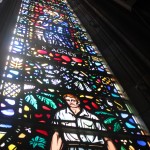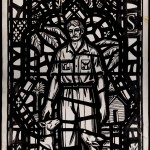There are few events more exciting for our library staff than receiving a call from our congressman’s office with congratulations on being awarded a federal grant. Our euphoria lingered for a couple of days before the reality of the work ahead of us set in! Little did we know that our Whitefriars grant project would take us on such an exciting journey, teach us to see stained glass in a different light, and introduce us to so many wonderful people.
The “Discovering the Whitefriars Collection” project team sought to develop a scalable solution to a seemingly impossible task: preserving, digitizing, and making accessible over 10,000 stained glass drawings, mostly works on paper drawn to scale (very large) but also tracings, photographs and cut-outs. Thanks to the generosity of the Institute of Museum and Library Services and the good collaborations of Westlake Conservators and Alex Werner of the Museum of London, our pilot project has been a success. In coordination with Moya Dumville of Westlake Conservators, we planned a methodology for conserving the rolls of drawings, and established a very successful internship program. Our interns, Natasa Krsmanovic and Nicole Monjeau, implemented and refined the methodology, setting a high standard for future interns to follow. Over the course of five months, the team unrolled, conserved, and digitized 15 rolls – 132 items in all. Perhaps most importantly, we met many wonderful people, including members of several congregations whose churches have Whitefriars stained glass windows: Saint Thomas Church in New York City, St. Stephen’s Episcopal Church in Olean, NY, and Park Church in Elmira, NY.
- The Albert Schweitzer window at St. Thomas Church in NYC.
- Silver gelatin photograph of Albert Schweitzer stained glass cartoon. CMGL 144584.
But, this is a time for more than just reflection on our successes. We need to improve and expand on our accomplishments and prepare for the work still ahead. Some improvements are process oriented, such as continuing to adjust our conservation process and using multiple methods of humidifying the rolls. Logistical considerations include installing new shelving specifically for the conserved rolls. These changes will help us speed up our work considerably.
Expanding the geographic scope of the project is essential. In 2015, we focused on Whitefriars installations in New York State. This was a logical step—it enabled us to visit the sites and develop a template for future outreach. But we also conserved drawings from installations in more distant places, including England, Sri Lanka, and the Solomon Islands. In 2016, we will continue to expand our reach, developing a list of priorities based on input from the team and our collaborators.

Nicola D’Ascenzo’s depiction of St. Martin of Tours in St. Thomas Church, NYC, was one of many beautiful stained glass works we saw during the project.
As we wrap up the first year of the project, we look forward to the next steps: continuing the conservation program in 2016 with a second pair of interns, implementing a Whitefriars website where people can access the digitized drawings and add their own content, and reaching out to more institutions with Whitefriars installations to begin more conversations about stained glass.
This pilot project also provided us with perspective. During the three months Natasa and Nicole spent with us, we conserved 15 rolls out of 1,800. With the workflows we develop, we would optimally conserve 50-60 rolls annually. This will be a long-term project, and we are committed to making steady progress on this important work. What has become clearer is how critical our relationships with institutions that have Whitefriars stained glass are in moving the project forward. To be successful, we must continue working with our partners to select rolls of greater interest to preserve and digitize; this will allow us to create a group-curated collection for researchers and glass enthusiasts to study and enjoy.
Finally, there are many people and organizations to thank: the project team, Natasa and Nicole, and the Museum administration; our collaborators Moya Dumville of Westlake Conservators and Alex Werner of the Museum of London; our new friends at Saint Thomas, St. Stephen’s, and Park Church, and the many people who have followed and supported our progress online. Most of all, we would like to thank the IMLS for making all of this possible.
Read more about this project in previous posts and see photos from the first year of the project.
This project was made possible in part by the Institute of Museum and Library Services (#LG-55-14-0110-14).
The Rakow Research Library is open to the public 9am to 5pm every day. We encourage everyone to explore our collections in person or online. If you have questions or need help with your research, please use our Ask a Glass Question service.



